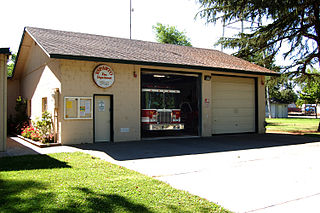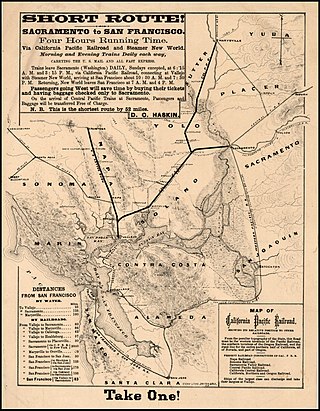
Esparto is a census-designated place (CDP) in Yolo County, California, United States. It is part of the Sacramento–Arden-Arcade–Roseville Metropolitan Statistical Area. The population was 3,108 at the 2010 census.

Niles Canyon is a canyon in the San Francisco Bay Area formed by Alameda Creek, known for its heritage railroad and silent movie history. The canyon is largely in an unincorporated area of Alameda County, while the western portion of the canyon lies within the city limits of Fremont and Union City. The stretch of State Route 84 known as Niles Canyon Road traverses the length of the canyon from the Niles district of Fremont to the unincorporated town of Sunol. Two railroads also follow the same route down the canyon from Sunol to Niles: the old Southern Pacific track along the north side, now the Niles Canyon Railway, and the newer Union Pacific track a little to the south. At the west end of the canyon are the ruins of the Vallejo Flour Mill, which dates to 1853.

The San Joaquin Valley Railroad is one of several short line railroad companies and is part of the Pacific Region Division of Genesee & Wyoming Inc. It operates over about 371 miles (597 km) of owned or leased track primarily on several lines in California's Central Valley/San Joaquin Valley around Fresno and Bakersfield. The SJVR has trackage rights over Union Pacific between Fresno, Goshen, Famoso, Bakersfield and Algoso. The SJVR also operated for the Tulare Valley Railroad (TVRR) from Calwa to Corcoran and Famoso.

The California Pacific Railroad Company was incorporated in 1865 at San Francisco, California as the California Pacific Rail Road Company. It was renamed the California Pacific Railroad Extension Company in the spring of 1869, then renamed the California Pacific Railroad later that same year. Its main railroad from Vallejo to Sacramento was completed six months prior to the May 1869 golden spike ceremony of the Central Pacific/Union Pacific Transcontinental Railway.

The California Northern Railroad is one of several Class III short-line railroad companies owned by Genesee & Wyoming, Inc. It operates over Southern Pacific Railroad (SP) tracks under a long-term lease.

The “Northwestern Pacific Railroad” was a 271 mile mainline railroad between the national railroad interchange at Schellville and the northernmost point at Eureka, with branches from Ignacio into Marin County. The railroad has gone through a history of different ownership and operators but has maintained a generic name of reference as “The Northwestern Pacific.” Currently, only a 62-mile (100 km) stretch of mainline is operated by Sonoma-Marin Area Rail Transit (SMART), which operates both commuter and freight trains with plans for extension north to Cloverdale, on the “South End.” The “North End,” from Willits to Eureka is saved by 2018 legislation to be converted into the Great Redwood Trail.
The Eagle Salt Works Railroad was a 13.5 mile shortline railroad that ran northeast from a connection with the Southern Pacific Company at Luva to Leete, Nevada. The line then branched from the old Central Pacific grade and went southeast for about 2 miles to the Eagle Salt Works.
Port Railroads, Inc. was a 105.7-mile (170.1 km) shortline railroad owned by Kyle Railways. PRI was formed on March 13, 1994, to take over two Southern Pacific Railroad lines. One of SP's lines was the West Side Line between Fresno northwest to Oxalis, California and a branch running from Ingle to Burrell. The other line was the SP Buttonwillow Branch from Bakersfield to Buttonwillow, California.
The Santa Maria Valley Railroad is a 14.8 miles (23.8 km) shortline railroad that interchanges with the Union Pacific Railroad's Coast Line at Guadalupe, California. As of 2006, the Railroad is owned by the Coast Belle Rail Corporation.
The Sacramento Valley Railroad (SVRR) was incorporated on August 4, 1852, the first transit railroad company incorporated in California. Construction did not begin until February 1855 because of financial and right of way issues, and its first train operated on February 22, 1856. Although the oldest working railroad in the state was the Arcata and Mad River Railroad, first operational in December 15, 1854, the Sacramento Valley Railroad was the West's pioneering incorporated railroad, forerunner to the Central Pacific.

The Sacramento Northern Railway was a 183-mile (295 km) electric interurban railway that connected Chico in northern California with Oakland via the California capital, Sacramento. In its operation it ran directly on the streets of Oakland, Sacramento, Yuba City, Chico, and Woodland and ran interurban passenger service until 1941 and freight service into the 1960s.
Rumsey is an unincorporated community and census-designated place (CDP) in Yolo County, California. It is located 18 miles (29 km) northwest of Esparto, in the Capay Valley, in the northwestern part of the county. Rumsey's ZIP Code is 95679 and its area code 530. It lies at an elevation of 420 feet.
The San Joaquin and Sierra Nevada Railroad was originally built as a 3 ft narrow gauge that ran from Bracks Landing to Woodbridge and Lodi and then east to the Sierra Nevada foothill town of Valley Springs. The railroad was incorporated on March 28, 1882 and construction was completed on April 15, 1885. The railroad was built as a common carrier with copper mining being its primary traffic. The track was built using 35/40 lb steel rails.

The Oregon Railroad and Navigation Company (OR&N) was a railroad that operated a rail network of 1,143 miles (1,839 km) running east from Portland, Oregon, United States, to northeastern Oregon, northeastern Washington, and northern Idaho. It operated from 1896 as a consolidation of several smaller railroads.
The Northern Railway was a non-operating subsidiary of the Southern Pacific Railroad during the 19th century, created primarily as a device to consolidate the management of a number of smaller subsidiary railroads. The initial railroad opened in 1876 from Woodland, California, to Williams; and extended to Willows in 1878, and to Tehama in 1882. In 1877, a line of the Northern Railway was built between Oakland and Martinez. By the time of its 1898 merger into Southern Pacific, it also controlled the Winters and Ukiah Railway, the Woodland, Capay and Clear Lake Railroad, the West Side and Mendocino Railroad, the Vaca Valley and Clear Lake Railroad, the San Joaquin and Sierra Nevada Railroad, the Sacramento and Placerville Railroad, the Shingle Springs and Placerville Railroad, the Santa Rosa and Carquinez Railroad, the Amador Branch Railroad, and the Berkeley Branch Railroad.
Cottonwood is a former settlement in Yolo County, California. It was located 2 miles (3.2 km) south of Madison, at an elevation of 164 feet. It still appears on maps as of 1917.
The Riverdale Branch of the Southern Pacific Railroad (SP) was a branch line serving the San Joaquin Valley's agricultural area southwest of Fresno. The 42 mile line ran from a connection with the Southern Pacific's West Side Line at Ingle, California and then ran southeast through Burrel, Riverdale beyond which it also connected to the Caruthers Branch of the SP. From Riverdale it continued Southeast to Hardwick then south to Armona where it connected to SP's Coalinga Branch.
This article lists the railroads and a timeline of railroad history in Solano County, California.
The 1892 Vacaville–Winters earthquakes occurred in northern California as a large doublet on April 19 and April 21. Measured on a seismic scale that is based on an isoseismal map or the event's felt area, the 6.4 and 6.2 Mla events were assigned a maximum Mercalli intensity of IX (Violent), and affected the North Bay and Central Valley areas. The total damage was estimated to be between $225,000 and 250,000 and one person was killed. No evidence of fault movement on the surface of the ground was observed as a result of either of the strong shocks. Both occurred in the domain of the San Andreas strike-slip system of faults, but their focal mechanism is uncertain.
The Elmira, Cortland and Northern Railroad was a railroad in the state of New York, in the United States. Its main line ran from Elmira, New York, to Camden, New York. It was formed in 1884 from the consolidation of other railroads and merged into the Lehigh Valley Railroad in 1905. Under the Lehigh Valley, it was known as the Elmira and Cortland Branch. Almost all of its former line has since been abandoned.








